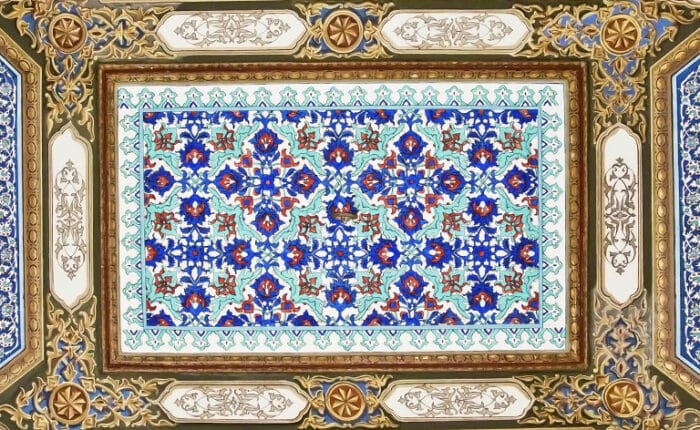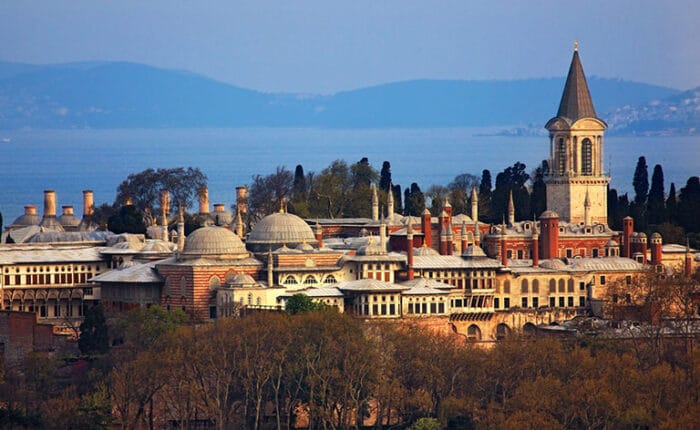A few years after conquering Constantinople, Mehmed II ordered the construction of Topkapi Palace. This new palace was to act as the royal seat of the Ottoman Empire Administration. He moved into the newly built castle in 1478, and after his death in 1481, successive sultans worked on its expansion and incorporated their custom decoration.
This went on for the entire 600-year reign of the Ottoman Empire, during which around 30 sultans ruled from the place. The resulting influences on the palace are mixtures of tastes of the Ottoman, European, and Islamic architectural styles and decorations.
In 1924, a year after Turkey became a republic, Topkapi Palace became a museum.
Topkapi Palace’s original layout consisted of four consecutive courtyards, each serving a different purpose. The design remains to this date, with each courtyard surrounded by high walls and separated from the adjacent one by a gate.
The surviving buildings like the Harem in the palace are low with one or two stories. These buildings continuously changed functions over the centuries.
This is the largest and only courtyard accessible to the public during ancient times. It has a large open space that made it ideal for hosting various ceremonies and processions. Visitors of Topkapi palace can see traces of workshops that belonged to artists and artisans who carried out exhibitions in the courtyard.
In the first courtyard, you will also get a glimpse of the different architectural styles used throughout the place.
The Gate of Salutation opens up to this courtyard, which served as the palace’s administrative center. During the Ottoman times, only official visitors and courtesans were allowed into the yard. It is home to the Domed chamber, where council members held meetings to discuss state affairs.
The palace’s tallest structure, the Tower of Justice, can also be found in this palace. This tower has a Neoclassical lantern that gave the Sultan a complete view of the palace. The palace kitchens and confectionaries (displays the imperial porcelain collection) also sit in the second courtyard.
Mehmed II and all the other Sultans gave keen notice on the detailing and improvement to Topkapi Palace’s interior; it was a world full of itself. There was a church, bathhouses, a kitchen, the Harem, horse stables, libraries, memories, and much more. The four courtyards surrounded the Harem with a long perimeter wall for safety.
Topkapi Palace is now a museum with most military, jewelry, and other collections on display for visitors to view. Mehmed himself had a distinct taste for art, paintings, and jewelry, all displayed at Topkapi Palace.
On a typical day during visiting hours, unending lines of curious tourists shall be found accessing the Harem, which sits at the center of the 173 acres of land. It was private to the Sultan and the other members, mostly women and male slaves.
The Harem was special and served to show the Sultan’s sexual prowess and train sub-kingdom couple leaders; however, not all women in the Harem had sex with the Sultan. Today, you can access the Harem’s then private partitions and see the beautiful art prints and designs in it.
Before you set your foot into Topkapi, there are a few pro tips that you should have for a smooth experience.
Topkapi Palace is a complex that covers an area of 173 acres of land.



Istanbul is among the world’s most detailed and most extensive cultural and historical cities. Therefore, Topkapi is surrounded by other interesting places and historical sites you can check out during the visit. These include the breathtaking Hagia Sophia, the grand Basilica Cistern, the Blue Mosque, the Hagia Irene, Galata Bridge, and so much more.
Therefore, as you explore Topkapi Palace, don’t forget to tour these other magnificent sites. The best way to enjoy all of these sites is to book a day tour of Istanbul’s top highlights.